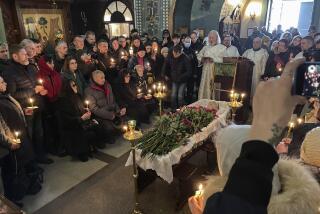Party Brass and Common People Bury Sakharov : Soviet Union: Human rights activist’s funeral is attended by Mikhail S. Gorbachev and thousands of everyday citizens. Some mourners use occasion to press for reforms.
- Share via
MOSCOW — Human rights champion Andrei D. Sakharov was buried today in the cold earth of the Russia he tried so hard to change, mourned by tens of thousands of countrymen and praised by the leadership that once reviled him.
“It’s over,” Sakharov’s wife and dissident comrade in arms, Yelena Bonner, said as she turned to a companion during the twilight burial in a Moscow cemetery.
Before Sakharov’s crimson-and black-trimmed coffin was lowered into the ground at Vostryakovskoye Cemetery, its cover was removed to allow Bonner to bid a final farewell. She removed the shroud from his face and bent to kiss him on the forehead.
Sakharov, who died Thursday of an apparent heart attack at the age of 68, was buried alongside Bonner’s mother, Ruth, a Stalin-era political prisoner who died in 1987 at age 87.
Top party brass riding sleek black limousines and tens of thousands of common people trudging through the slush joined in paying their last respects to the Nobel laureate.
President Mikhail S. Gorbachev and other ruling Politburo members stood in icy morning rain to view the body outside the Academy of Sciences, to which Sakharov, a creator of the Soviet hydrogen bomb, belonged. Gorbachev spoke at length with Bonner.
“Now it is clear that he deserved the Nobel Prize,” Gorbachev told reporters. Sakharov was denied permission to travel to Norway to accept the 1975 prize for his human rights campaign. He was hounded for years and finally banished into internal exile by past Soviet leaders.
Some marchers carried protest signs demanding democratic elections, echoing the final cause of Sakharov before he died last week. Others hoisted the blue-red-white flag of czarist Russia, now the symbol of the grass-roots pro-democracy Russian People’s Front.
More than 8,000 grieving Soviets followed Sakharov’s body, transported in an open-ended bus that also carried Bonner along Lenin Prospekt to outdoor funeral ceremonies at Luzhniki sports complex. The southern Moscow facility is a favorite site for rallies by human rights activists.
In the Kremlin, the 2,250-member Soviet Congress, to which Sakharov belonged, adjourned at midday so its members could attend the ceremony.
State-run television showed excerpts of the service in a special broadcast of the kind usually reserved for the deaths of major government figures.
At the outdoor service, the crowd surged dangerously forward toward Sakharov’s coffin and Bonner had to plead for order. The coffin was then transported nine miles in a bus along slush-filled streets to the cemetery.
In the afternoon, tens of thousands of mourners gathered at the Luzhniki stadium parking lot for a memorial service.
Sakharov “did all he could,” said Ilya Zaslavsky, a Moscow member of the Soviet Congress. “Now only his ideas can change things, and only we can fulfill his ideas.”
More to Read
Sign up for Essential California
The most important California stories and recommendations in your inbox every morning.
You may occasionally receive promotional content from the Los Angeles Times.













